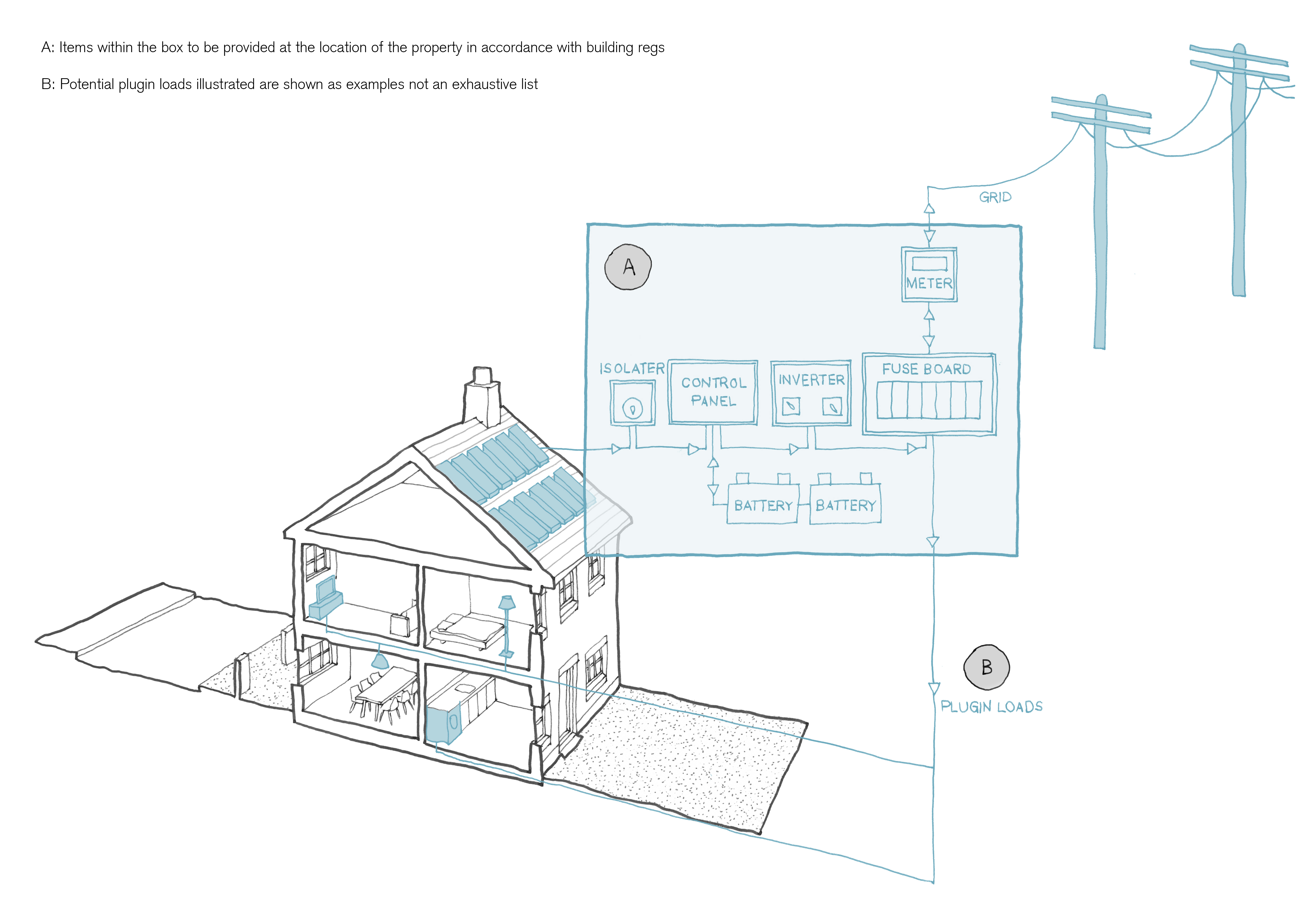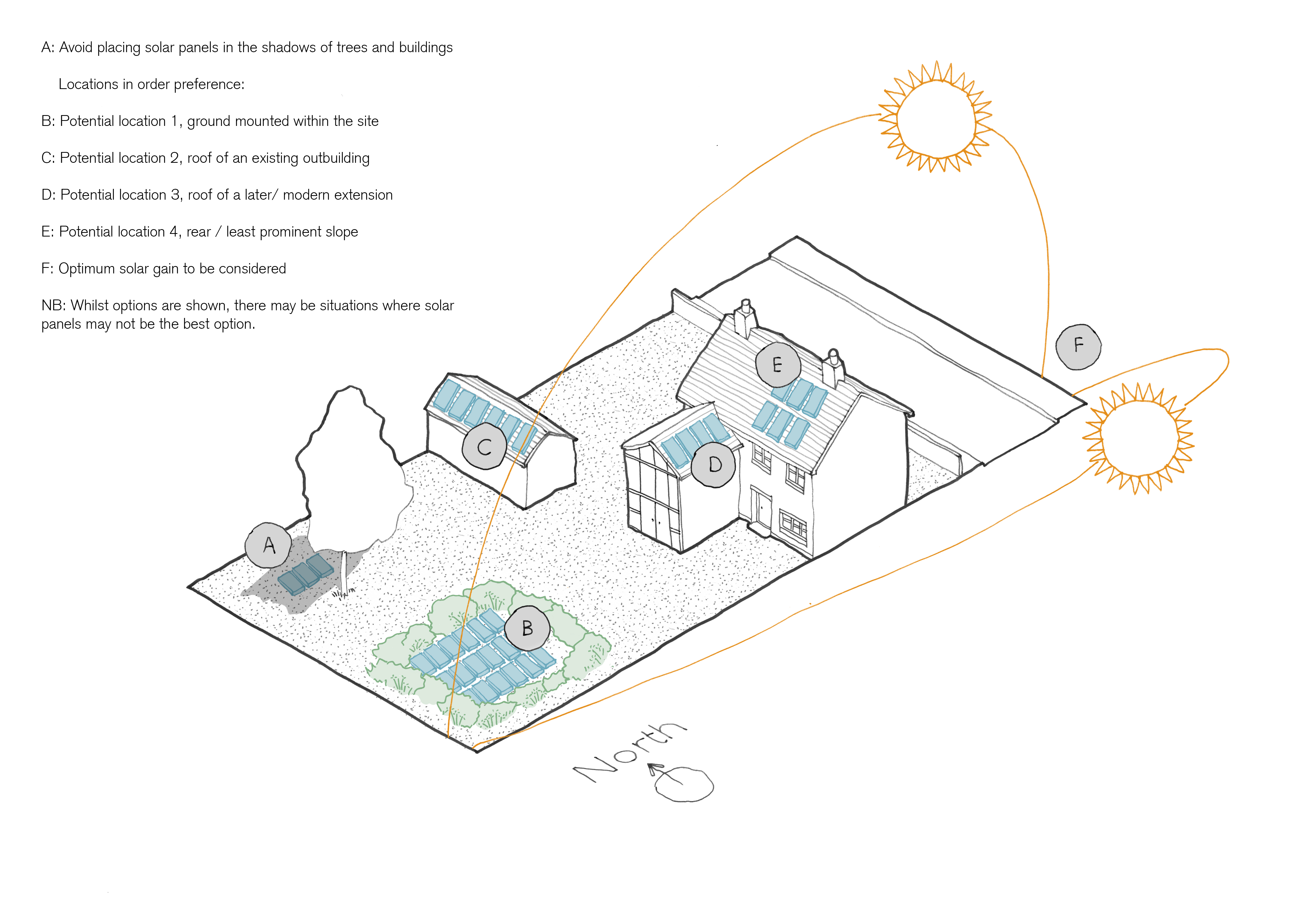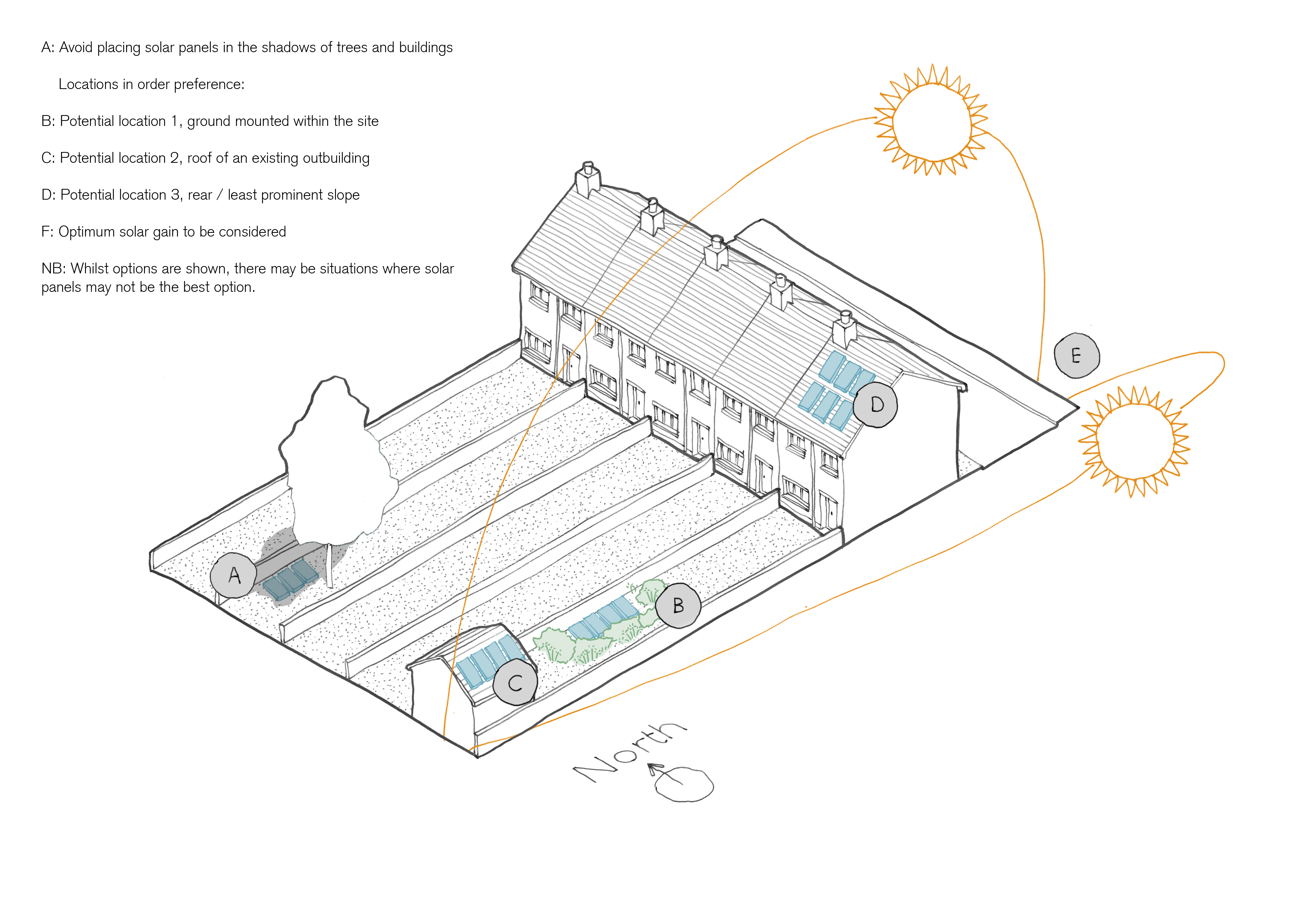Solar
Solar energy is a renewable source converted through panels. Photovoltaic (PV) Solar Panels converts sunlight energy into electricity, whereas Solar Thermals uses solar to heat water.
When considering solar technology, the following should be taken into account:
- Location and orientation of the panels with regards to visual impact and effect on designated areas;
- Location and orientation of the panels for solar gains;
- Size and area of solar modules for required energy output for the household;
- Design of panels, particularly for PV panels as the colour and appearance can vary
- Approach to planning the installation, ongoing maintenance, and removal of PV panels at the end of their useful life (the expected lifespan of a PV array and its associated equipment is typically much shorter than the roof covering).
The visual impact needs to be considered if panels are installed on a heritage asset. Whilst the visual impacts can be minimised, this needs to be considered in the context of solar gains. If the orientation is north facing to minimise the visual impact, there will be minimal gains.
Generally, the following design considerations and criteria should be taken into account when installing solar technology onto a traditional building:
- Planning the location of panels should be treated sequentially. If possible, installing panels within the grounds of the heritage asset should be considered in the first instance. Ground mounted solar panels may be installed and their location potentially screened to avoid adverse aesthetic impacts. This will also have benefits as application to roof pitches determine the aspect of a panel which is not an issue in the ground mounted option. If this is not possible the outbuildings and ancillary buildings should be considered before the listed building itself.
- Equipment on a building should be sited, so far as is practicable, to minimise the effect on the external appearance of the building and the amenity of the surrounding area.
- Panels should not be installed above the highest part of the roof (excluding the chimney) and should project no more than 200mm from the roof slope or wall surface.
- Panels should not face onto the street (particularly if a designated asset)
- Panels should be located on the least sensitive parts of the building, for example a later rear extension (particularly if the building is a designated asset)
- When no longer needed equipment should be removed as soon as reasonably practicable.
Choosing a location for a proposed solar array
Whilst sustainability and energy efficiency are legitimate issues, for historic buildings a balance must be achieved between generating its own energy and avoiding damage both to the significance of the building and its fabric, and the visual impact of a renewable installation on the character and appearance of the historic building or site.
When choosing a location for a proposed solar array it is considered best practice to appraise each option sequentially in the following order of preference:
- Ground-mounted
- To the roof of any outbuilding (such as a garage or shed)
- To the roof of a later / modern extension
- To the rear roof slope of the host dwelling
Before a proposed location can be supported in principle it must be adequately demonstrated that the previous preferred option(s) are not viable.
It should be noted that demonstrating that a preferred alternative location is not viable, does not mitigate any potential harm caused by solar panels to roofs, and some heritage assets may not have the capacity for this change. There is no presumption of acceptability without carefully considered options.
Key Documents and Links
Historic England Energy Efficiency and Historic Buildings: Solar Electric (Photovoltaics).
Historic England Installing Solar Panels
Campaign to Protect Rural England: Solar Design Tips
Photovoltaic (PV) Solar Panels
The main components of these systems are the PV panels, inverter, isolator, electrical distribution system, and often battery storage.
PV panels can be ground mounted or mounted onto buildings. Ground mounted solar panels involve limited intervention with the building fabric so can be a good solution where space and facilities allow. For properties that do not have sufficient space, installing PVs on the building may be the only option.
For panels installed on roof slopes, there are two different types of panels: fixed over the roof covering and integrated into the roof.
Panels that are fixed onto the roof have the potential for greater solar gains, due to their size and positioning. There is also less fabric intervention, and it is reversible. Generally, to mount the panels onto the roof, roof tiles are removed in specific areas for the batons to be fixed into the timber rafters. Cabling is installed and the tiles are then replaced. The invertor, isolator, electrical distribution system, and battery storage (if applicable) is stored internally. The majority of the built fabric has no intervention. There is however an aesthetic impact. Some roof structures in historic buildings are also of significance and cannot be altered due their significance, or structural integrity, to accommodate a PV.
Integrated solar panels, also referred to as in-roof solar panels, have the potential to limit visual impact in some instances. However, they are only compatible with certain roof tiles and slates and require the existing roof tiles to be removed. Therefore, they can have a significant amount of fabric intervention and are not a reversible solution. Overtime, there may be weathering to the roof tiles, that result in the PV panels being more prominent. Due to the scale and design of the panels, they have less solar gains and energy output as fixed panels. Generally, they should only be considered if the whole roof is being replaced, due to the disruption and loss of fabric.
Solar roof slates are small solar panels which absorb sunlight and generate electricity in exactly the same way. The key difference is that they perform just like normal roof tiles or slates and have less of a visual impact. However, as solar slates are engineered, they lack the authentic matt finish provided by natural slate; in this sense they represent the same problems as artificial slates in the historic built environment and may not be appropriate in some instances.
The Solar Energy Calculator provides estimates for the potential for fuel bill savings. The interactive tool calculates the estimate based on the potential for solar gains, including property details, roof slope, shading roof direction, and installation size.
Solar Thermals
The main components of solar thermals are solar panels/tubes (which are typically roof mounted), a pump managed by a controller unit and a hot water cylinder with heating coils.
Whilst the size of thermals varies, there is little alteration in design, and these can appear more prominent so particular care needs to be given to their orientation and location. The size of the solar thermals should be determined by the size of the household and the hot water usage. For heating water, solar thermals can be more efficient than PVs.
Further information on solar
Solar Thermals
CAT, Solar Water Heating
Centre for Sustainable Energy, Solar hot water
Simple Energy Advice, Solar thermal
Solar Panels
Historic England’s Solar Electric (Photovoltaics)
Historic England Installing Electrical Energy Storage Systems and Batteries in Historic Buildings
CAT, Photovoltaic (PV) Solar Panels
Centre for Sustainable Energy, Solar electricity
Centre for Sustainable Energy, Battery storage
Centre for Sustainable Energy, Getting the most of solar panels
CPRE, Solar Design
CPRE and BRE, Ensuring place-responsive design for solar photovoltaics on buildings
Simple Energy Advice, Solar electric panels
Page updated: 16/04/2024


